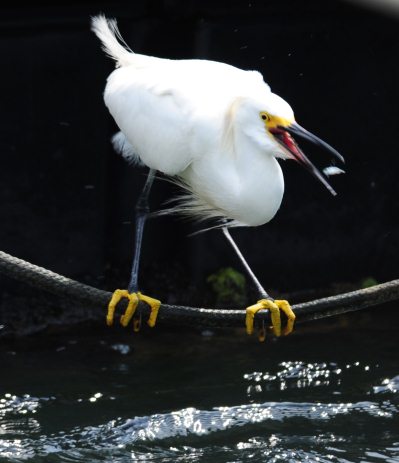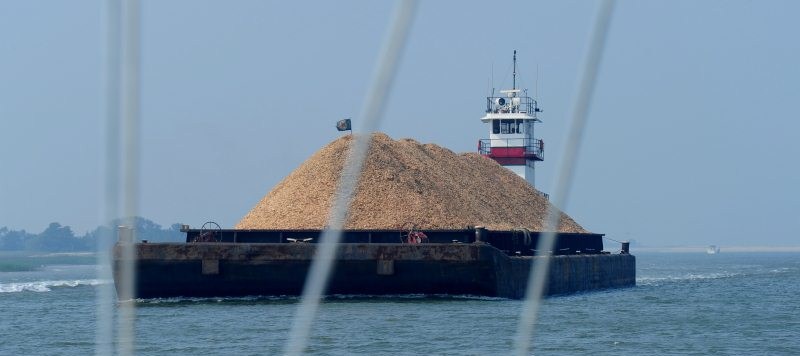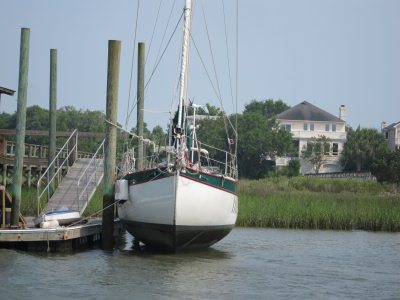To Mark Bay

|
Sunset Marina, Charleston To
Mark Bay, South Carolina
     Bear went to the marina office to get us booked out. While he was gone, I watched this little chap who was using our front rope as a feeding platform. He was having an easy time with breakfast; all he had to do was pick off the tiny fish from the surface of the water, as the tide swished through, toss his catch up and swallow whole. Simple but so quick.
All sorted, we left Sunset Marina at 11:15 on a rising tide, good to be on the move again, especially today our third anniversary of our At-Venture. Leaving the marina, almost out to sea and along the Stono River. Passing my favourite 'Munsters' house. It has to have the longest boat jetty ever. I can just imagine the man of the house calling out "I'm just going to paint the fence, dear". Must be like owning and maintaining the Severn Bridge. Up Elliott Cut, through the bridge (on request) and out into Charleston Harbour, such a huge area.
It seem funny that the by car to the centre of Charleston took about half an hour; it took us over three hours on Beez. We passed where we ate last night, USS Yorktown and finally Fort Sumter at 2:45.
Fort Sumter is a Third System masonry coastal fortification, best known as the site upon which the shots initiating the American Civil War were fired, at the Battle of Fort Sumter. Named after General Thomas Sumter, Revolutionary War hero, Fort Sumter was built following the War of 1812, as one of a series of fortifications on the southern US coast. Construction began in 1827, and the structure was still unfinished in 1861, when the Civil War began. Seventy thousand tons of granite were imported from New England to build up a sand bar in the entrance to Charleston Harbour, which the site dominates. The fort was a five-sided brick structure, 170 to 190 feet long, with walls five feet thick, standing 50 feet over low tide mark. It was designed to house 650 men and 135 guns in three tiers of gun emplacements, although it was never filled near its full capacity. The Confederacy attacked Fort Sumter on Friday the 12th of April 1861 at 4:30am. The battle continued overnight until Saturday, the two day bombardment resulted in the surrender of the Union troops. With the North's withdrawal, the South held the fort until it was finally evacuated on the 17th of February 1865. During that time, the fort experienced one of the longest sieges in modern warfare. For almost two years, 46,000 shells, estimated at more than seven million pounds of metal, were fired at the Fort. For these reasons and more, Fort Sumter remains one of the most significant historic monuments in the USA. I put in the aerial shots from the net as the second shows the sheer size of the water we crossed.
Leaving Charleston and through Ben Sawyer Swing Bridge at 15:40. Huge river until.....
. What I thought was the biggest sand pit coming toward us. It was in fact a barge full of wood chippings pushed by a tug called Royal Engineer
Once again in a more normal width area of water, we saw a girl resting on low tide. We left the ICW after thirty one miles and literally dropped the hook round a corner called Mark Bay. Idyllic, silent, no thrapping or clanking, just peace and quiet.
ALL IN ALL A GOOD FIRST DAY ON THE MOVE AGAIN NORTHWARD |
















